Who was Manco Inca Yupanqui or Manco II? Manco Inca, also called Manco II, was one of the sons of Huaina Cápac with the imperial Coya of Cusco. He was probably born in 1515. He was named Zapa Inca Pizarrista shortly after Túpac Huallpa (Toparpa) died. His promotion to Zapa Inca was agreed upon in the meeting he had with Pizarro in Jaquijahuana. The recognition of him and placement of the mascapaycha occurred in Cusco. Faithful to the terms of the acquired commitment, he initially collaborated with Pizarro on everything. He came to help him in the war against the rebel troops of General Quizquiz, until he was removed from Huánuco and placed at the mercy of the Spaniards and Huascaristas in the northern lands. But the harmony between Francisco Pizarro and Manco Inca was short-lived. Not because of him but because of the chapetones, until Hernando Pizarro arrived from Spain and set him free in February 1536; but without him being able to leave Cusco.
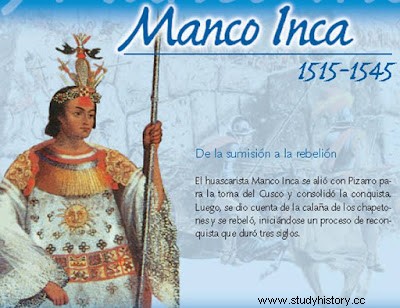
His flight from him to Calca Fed up with that situation, he plotted a deception. "As proof of gratitude" -he says- he gave Hernando Pizarro a set of gold, some gold statues, aríbalos full of gold powder and silver beams from the Coricancha. When he observed that the conqueror's ambition was growing, he told Hernando Pizarro that he was going to bring him the statue of Huaina Cápac, "all gold, even the guts." The ambitious Spaniard believed him. Manco Inca left Cusco on April 18, 1536 and never returned. His first refuge was Calca. In coordination with the high priest Villac Umo or Villaoma (there is no doubt if it was his title or proper name) he called his faithful generals and curacas and assembled a powerful army. He had the advantage that he had lived with the Spaniards and knew about their customs, their "bad arts", the power and handling of their weapons, their war tactics, the mastery of the horse and their tools and their excessive ambition for gold. and silver.
A vibrant proclamation From his refuge in Calca, Manco Inca Yupanqui launched the following harangue:“I am determined not to leave any Christian alive in the whole earth and for this I want to first put a fence around Cusco; whoever of you thinks of serving me, serving me in this, must put his life on such a case; drink from these vessels and on no other condition.” His generals were arriving and each one of them drank the chicha (sacred drink) as a sign of approval and dedication to the cause of the reconquest. He appointed Villaoma as chief of his army and Paucar Huaman as field marshal.
Manco Inca wins the battles of Calca and Yucay Thousands of Inca warriors joined him, including a Spaniard. Hernando Pizarro, aware of feeling guilty for the Inca's escape, organized his army and went in search of Calca. Manco Inca's troops confronted the Spaniards and made them flee, chasing them to the outskirts of Cusco. In the Yucay valley he returned to fight against the forces of Gonzalo Pizarro; but he also defeats them and makes them flee.
Two fronts of attack were formed against the conquerors From May 1536, Manco Inca prepared the attack against the conquerors on two fronts:one, to Lima; another, to Cusco. His objective was to cut communications between Francisco Pizarro and Hernando Pizarro. Let there be no aid between the Spanish armies of both cities. He himself was in charge of the offensive to the imperial city. Prince Quisu Yupanqui led the offensive to Lima. The first offensive lasted from May 1536 to April 1537. By then, many chiefs and warriors of both imperial troops had learned to use the European elements of warfare (riding on horseback, using arquebuses, crossbows, etc.).
Manco Inca's troops take Cusco In the month of May 1536, Manco Inca, with the siege of Cusco, was leaving for history lessons of heroism. He was "willing to liquidate the barbudos or suncasapas." After a week of fierce fighting, the troops of Manco Inca and Villaoma managed to corner the enemies in the central buildings of the city and in the main square. Seeing themselves almost defeated, the Spaniards knelt, begging for mercy. "Santiago! Goodbye Santiago. Santa Maria! Good luck Santa Maria. Help us God!”
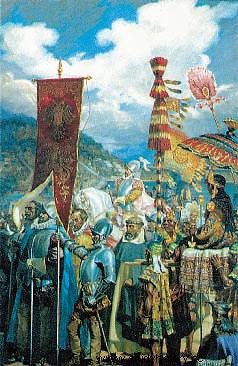 Manco Inca, the new Zapa Inca, appears on the right side
Manco Inca, the new Zapa Inca, appears on the right sideof the illustration Hernando Pizarro breaks the fence On the seventh day, Hernando Pizarro plots a desperate stratagem.a). He orders his cavalry to go out on the road to Chinchasuyu, simulating flight. b). Curi Atao, Cuillas and Taype, the generals who, with their troops, guarded that part of the fence, fell for the ruse and ordered them to let them pass because “they are going to Castile; catch them!” They prefer to chase them off-road. The horses are faster there. c). Broken the fence, Hernando Pizarro decides to go to Sacsayhuamán and take it. d). General Pascaq, his ally, warned of Hernando Pizarro's strategy, goes to his aid and approaches the fortress. e). Villaoma and Paucar order their armies to retreat to the fortress, because they were in danger of being defeated at its foot by the combined forces of Hernando Pizarro and Pascaq.
The fight for the fortress and the death of Juan Pizarro The fortress of Sacsahuamán or Sacsayhuamán (located at an altitude of 3,691 m), the gateway to Cusco, was the site of continuous combat between both armies. The army of Villaoma and Paucar tried, by all means, to defend it; it was a rebel stronghold of great significance. The Pizarro-Pascaq and the Huaypar and Inguill (brothers of Manco Inca) did everything possible to gain the fortress and end the siege of Cusco. In one of these confrontations, Juan Pizarro received a stone in the head “[...] and from there he died fifteen days later”.
The Incas as fencers become fenced The indigenous-Spanish troops then made the decision to surround the fortress. In this way, they made it impossible for Manco Inca's rebels to receive support, food and supplies. When these elements began to be scarce in Sacsayhuamán, the Zapa Inca's lieutenant asked his staff what to do. Most agreed to withdraw; but there was a daring indigenous warrior who fought to the point of offering his life for the reconquest. For Edmundo Guillén, he was called Titu Kusi Huallpa, "one of the sworn in Calca." For others, he is simply Cahuide. Pedro Pizarro narrates how Cahuide died:“Raising one of the Spaniards by two or three parts, they won the cube. Seeing this orejon that had been taken by two or three parts, the fort, throwing the weapons, threw itself from the bucket down more than a hundred states and thus it broke into pieces. With Cahuide dead, it was easy for the Spanish to take the fortress of Sacsayhuamán. Two thousand Inca warriors were put to the knife by the bloodthirsty hosts of the combined Indian-Spanish army. The Pizarros would make it go down in history as another feat of theirs. The truth is that this adverse result for the rebels and for the reconquest was settled between the Incas themselves, in another episode of the traditional rivalry of the royal panacas.
Manco Inca rejects Pizarro Manco Inca, by then, had chosen the fortress of Ollantaytambo as his center of operations. It is said that, in a very audacious military operation, Hernando Pizarro enlisted an army and set out to take said rebel stronghold. He marched from Cusco with his cavalry and 30 thousand Indian warriors. They were the troops of the Incas Huaypao and Inguill. He set up his camp in the Urubamba valley, very close to Ollantaytambo. One day, he dared to storm the fortress; but he saw that Manco Inca was riding a spirited steed, preparing his troops to repel the aggression. The Inca's counteroffensive took place, with several shots from arquebuses and the appearance of thousands of warriors on the parapets of the pucara. Hernando Pizarro had no alternative but to order the withdrawal. Manco Inca was already preparing to attack them at his base camp. Sniffing out the imminent danger and taking advantage of the arrival of night, Hernando Pizarro ordered the return to Cusco. So hasty was this measure that the Spaniards left the field awnings abandoned.
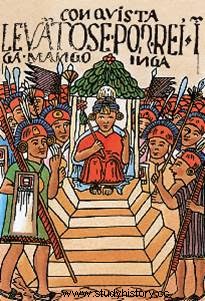 Manco Inca and his court, according to Felipe Guaman Poma de Ayala Almagro and Paullu Inca dominate the situation The secret alliance Almagro-Paullu Inca soon had its public expression. After a skirmish, they took Cusco and imprisoned the Pizarro brothers. Manco Inca decided to move away from Ollantaytambo and take refuge in Vitcos and Vilcabamba, to enlist and restart the war of reconquest. On July 12, 1537, the Almagro-Paullu Inca alliance defeated the troops of Alonso de Alvarado in Abancay. Almagro, to consolidate himself in power, appoints Paullu Inca as Zapa Inca. The new "Zapa Inca" loses a historic opportunity Manco Inca Yupanqui secretly sent Paullu Inca to join him in annihilating the Spanish and restoring Tahuantinsuyu. Paullu Inca did not accept. He asked her to surrender. "The Spaniards are many," he told her. He guaranteed her "good treatment" and that he "could give her the mascapaycha." Faced with this unprecedented response, Manco Inca and his small army headed through the Amaybamba valley. To take care of his withdrawal, because Almagro had ordered Marshal Rodrigo de Orgóñez to pursue him and capture or kill him, he had the bridges burned. But Orgóñez-Paullu Inca's troops continued to advance. Manco Inca crossed the Chuquicara bridge and took refuge in the Vitcos palace. There he was surprised by the indigenous-Spanish army. Manco Inca, Villaoma and those loyal to him were barely able to escape and hide in a nearby region.
Manco Inca and his court, according to Felipe Guaman Poma de Ayala Almagro and Paullu Inca dominate the situation The secret alliance Almagro-Paullu Inca soon had its public expression. After a skirmish, they took Cusco and imprisoned the Pizarro brothers. Manco Inca decided to move away from Ollantaytambo and take refuge in Vitcos and Vilcabamba, to enlist and restart the war of reconquest. On July 12, 1537, the Almagro-Paullu Inca alliance defeated the troops of Alonso de Alvarado in Abancay. Almagro, to consolidate himself in power, appoints Paullu Inca as Zapa Inca. The new "Zapa Inca" loses a historic opportunity Manco Inca Yupanqui secretly sent Paullu Inca to join him in annihilating the Spanish and restoring Tahuantinsuyu. Paullu Inca did not accept. He asked her to surrender. "The Spaniards are many," he told her. He guaranteed her "good treatment" and that he "could give her the mascapaycha." Faced with this unprecedented response, Manco Inca and his small army headed through the Amaybamba valley. To take care of his withdrawal, because Almagro had ordered Marshal Rodrigo de Orgóñez to pursue him and capture or kill him, he had the bridges burned. But Orgóñez-Paullu Inca's troops continued to advance. Manco Inca crossed the Chuquicara bridge and took refuge in the Vitcos palace. There he was surprised by the indigenous-Spanish army. Manco Inca, Villaoma and those loyal to him were barely able to escape and hide in a nearby region.The looting of Vitcos and Almagro's departure The first thing Orgóñez does is loot Vitcos. He finds abundant gold and silver, where a large image of the sun stands out, made of fine gold. Also, the body of Huaina Cápac, embalmed, and that the Incas had taken there to hide it from the sight of the Spaniards when they arrived in Cusco. The mummy of Huaina Cápac and the gold Inti were given to Paullu Inca as a reward for his services. When Orgóñez was preparing to continue the persecution, he received Almagro's order to return to Cusco. They had to go to the City of Kings to complete negotiations on his governorship with Francisco Pizarro. Indeed, Almagro left Cusco on November 15, 1537, taking Hernando Pizarro prisoner.
Manco Inca retires Manco Inca, whose main center of resistance was already Vilcabamba, took advantage of this situation and organized several expeditions to the central zone of Peru, between the first months of 1538. His purpose was to unify the curacas of the region and rebuild the army of the. But he encounters serious difficulties, those that have dragged on since long ago and manifested themselves in a resentment against the people of Cusco and a current adherence to the Spaniards, their "liberators." For example, the Huancas declared their staunch enemies. They engage several of his expeditions, killing some of his generals and hundreds of his soldiers. The last expedition is commanded by himself. He manages to punish the Huancas by removing the Huari Huillca idol from his temple, dragging it and throwing it into the Mantaro River. But not even with that reckless measure did he achieve the collaboration of that ethnic group or of others from the central zone of Peru. Manco Inca, disappointed, ordered the retreat to Vilcabamba. For this reason, when Francisco Pizarro passed through Hatun Jauja on July 28, 1538, the area was totally peaceful, more Anti-Cusco than ever.
Paullu Inca and a coup lucky The Pizarro-Paullu family dominated the entire southern zone. Manco Inca had taken refuge in Vilcabamba. Gonzalo Pizarro and Paullu Inca began their campaign against the last rebel stronghold in July 1539. At the Chuquillusca pass, the unsubdued Incas almost put them to flight. Paullu Inca prevented the escape of the Spaniards because he rebuked them for their conduct. Just so as not to be branded as cowards, the Pizarristas continued on the expedition. Near Hatun Pucara they were going to fall into a terrible ambush. Luck was on their side once again, because a pebble fell from above onto Gonzalo Pizarro's boots, alerting him. Immediately, Pizarro ordered his troops to shelter from him, while huge rocks fell from above. The pass was completely covered. The Pizarro-Paullu army had remained a very short distance away, safe and sound.
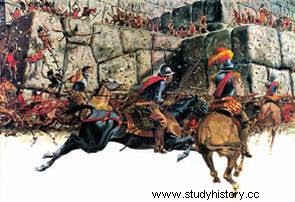 National Geographic painting illustrating what the battle of Sacsayhuamán would have been like The fierce battle at the Hatun Pucara After the scare and after a few days, the Pizarro-Paullu arrived at the Hatun Pucara base, ready to take it over. That fortress was located on the banks of the Pampacona River, at the top of a ravine, 3 leagues (16.5 km) from the city of Vilcabamba. The forces of Manco Inca had barricaded themselves there. The Pizarro-Paullu surrounded them and besieged them fiercely. The skirmishes lasted about 10 days. It was fought in a rugged jungle area, full of cliffs, forests and weeds. Manco Inca's forces managed to kill Huaypar and Inguill, the treacherous brothers of the Inca. But, in a counterattack, the Pizarro-Paullu took the upper part of the ravine, above the fortress. From that position, the arquebuses, crossbows and stones began to make a dent in the Inca army. The Inca's wife, Coya Cura Ocllo, and her brother Cusi Rimachi were taken prisoner. Manco Inca, at the request of his loyalists, jumped into the Pampacona River, swam across it and escaped from the Pizarro-Paullu family.
National Geographic painting illustrating what the battle of Sacsayhuamán would have been like The fierce battle at the Hatun Pucara After the scare and after a few days, the Pizarro-Paullu arrived at the Hatun Pucara base, ready to take it over. That fortress was located on the banks of the Pampacona River, at the top of a ravine, 3 leagues (16.5 km) from the city of Vilcabamba. The forces of Manco Inca had barricaded themselves there. The Pizarro-Paullu surrounded them and besieged them fiercely. The skirmishes lasted about 10 days. It was fought in a rugged jungle area, full of cliffs, forests and weeds. Manco Inca's forces managed to kill Huaypar and Inguill, the treacherous brothers of the Inca. But, in a counterattack, the Pizarro-Paullu took the upper part of the ravine, above the fortress. From that position, the arquebuses, crossbows and stones began to make a dent in the Inca army. The Inca's wife, Coya Cura Ocllo, and her brother Cusi Rimachi were taken prisoner. Manco Inca, at the request of his loyalists, jumped into the Pampacona River, swam across it and escaped from the Pizarro-Paullu family.Death and Premonition Gonzalo Pizarro sent word to Manco Inca that he was giving him 30 days to turn himself in. But he didn't reply. Urged by the hostile climate of the Rupa-rupa, Gonzalo Pizarro had to return to the Yucay Valley. In November 1539, Francisco Pizarro did the same. Between both brothers they agreed to blackmail Manco Inca. They sent word that if he did not turn himself in, they would kill his wife and sister, Coya Cura Ocllo, a beautiful young woman, daughter of Huaina Cápac, with arrows. Manco Inca showed indignation at the proposal and rejected it. Cura Ocllo also responded bravely. When her archers were in front of her, he said to them:“Do you avenge your anger on a woman? What else would another woman like me do? Hurry up, finish me, because she fulfills your wishes in everything ”. Pedro Pizarro, the chronicler, acknowledged that his uncle met a tragic end for having this "Inca princess" killed.
The rebel Incas raid the Pizarristas Manco Inca bravely overcame that tragedy. Convinced that "very soon the Paullu Incas would realize the bad faith of the Spaniards" and would bow to their hosts, he organized guerrilla warfare. That tactic consisted of attacking unexpectedly and then hiding. With this system, he had in check the enemy forces that moved between San Juan de la Frontera de Huamanga and Cusco. Illa Túpac also applied this tactic in the Cápac Ñam, between the Huanucus and the Cajamarcas.
The tactics of Manco Inca When in 1542 he learned of the death of Francisco Pizarro, Manco Inca supported Diego de Almagro "El Mozo". He sent him horses, weapons and warriors to face Vaca de Castro. Fatally, "El Mozo" was defeated in Chupas, on September 16, 1542. Manco Inca, however, received a group of almagristas who took refuge in Vitcos. When Gonzalo Pizarro rebelled against the Spanish Crown and faced Viceroy Blasco Núñez de Vela, Manco Inca sent word to the Viceroy that he would support him. There was no such occasion, because Núñez de Vela was killed in the battle of Añaquito.
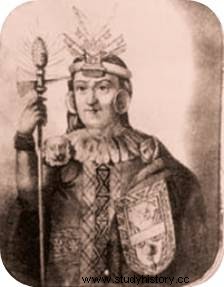 Portrait of Manco Inca Death of Manco Inca Captain Alonso de Toro, lieutenant governor of Cusco, with the authorization of Gonzalo Pizarro, began secret negotiations with the Vitcos almagristas. He offered them forgiveness and freedom if they killed the Inca. The almagristas accept this condition and assassinate Manco Inca in the first months of the year 1545. According to his son Titu Cusi Yupanqui, the assassination of Manco Inca would have taken place in the following way:“They were one day with great joy playing herrón (note :old game with iron yew, which had a hole in the center, and which was to put in a nail driven into the ground) only my father and them and me, who was then a boy, without my father thinking anything or having He gave credit to an Indian woman of one of them, called Bauba, who had told him many days before that those Spaniards wanted to kill him. Without any suspicion of this or anything else he was enjoying himself with them as before; and in this game, as I have said, when my father went to pick up the herrón to play, they all unloaded on him with daggers and knives and some swords; and my father, as he felt wounded, with great rage of death, tried to defend himself from one side and the other; but since he was alone and they were seven, and my father had no weapon, they finally threw him to the ground with many wounds and left him for dead. And some Andes, who arrived at that time and Captain Rimachi Yupangui, later stopped them in such a way that before they could flee a long way, some of them took the wrong road for their grade, overthrowing them from their horses below, and bringing them by force to sacrifice them. All of whom gave very crude deaths. Despite his fatal injuries, Manco Inca Yupanqui still lived a few more days. Titu Cusi Yupanqui was wounded; but soon he recovered. The 7 escutcheons, after being tortured, were executed. Their skulls were placed on pikes and exhibited for many years in the Vilcabamba plaza, as a lesson. Titu Cusi Yupanqui remembers that in one of the last conversations he had with his dying father, he told him:"...do not allow them to enter your land, even if they invite you more with words, because their sweet words deceived me and so they will do to you if you believe them.”
Portrait of Manco Inca Death of Manco Inca Captain Alonso de Toro, lieutenant governor of Cusco, with the authorization of Gonzalo Pizarro, began secret negotiations with the Vitcos almagristas. He offered them forgiveness and freedom if they killed the Inca. The almagristas accept this condition and assassinate Manco Inca in the first months of the year 1545. According to his son Titu Cusi Yupanqui, the assassination of Manco Inca would have taken place in the following way:“They were one day with great joy playing herrón (note :old game with iron yew, which had a hole in the center, and which was to put in a nail driven into the ground) only my father and them and me, who was then a boy, without my father thinking anything or having He gave credit to an Indian woman of one of them, called Bauba, who had told him many days before that those Spaniards wanted to kill him. Without any suspicion of this or anything else he was enjoying himself with them as before; and in this game, as I have said, when my father went to pick up the herrón to play, they all unloaded on him with daggers and knives and some swords; and my father, as he felt wounded, with great rage of death, tried to defend himself from one side and the other; but since he was alone and they were seven, and my father had no weapon, they finally threw him to the ground with many wounds and left him for dead. And some Andes, who arrived at that time and Captain Rimachi Yupangui, later stopped them in such a way that before they could flee a long way, some of them took the wrong road for their grade, overthrowing them from their horses below, and bringing them by force to sacrifice them. All of whom gave very crude deaths. Despite his fatal injuries, Manco Inca Yupanqui still lived a few more days. Titu Cusi Yupanqui was wounded; but soon he recovered. The 7 escutcheons, after being tortured, were executed. Their skulls were placed on pikes and exhibited for many years in the Vilcabamba plaza, as a lesson. Titu Cusi Yupanqui remembers that in one of the last conversations he had with his dying father, he told him:"...do not allow them to enter your land, even if they invite you more with words, because their sweet words deceived me and so they will do to you if you believe them.”SOURCE:Julio Villanueva Sotomayor "Manco Inca" Biographies
